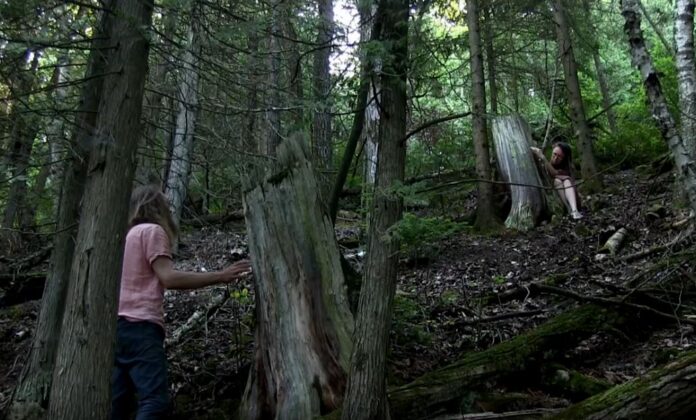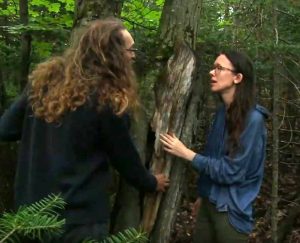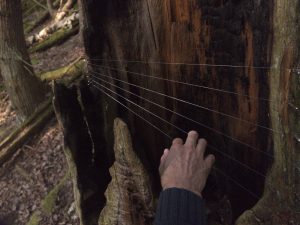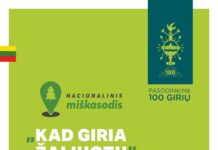
A round is a musical composition, a limited type of canon, in which a minimum of three voices sing exactly the same melody in unison (and may continue repeating it indefinitely), but with each voice beginning at different times so that different parts of the melody coincide in the different voices, but nevertheless fit harmoniously together.
Lithuanian Jurgita Žvinklytė and Matti Palonen, a Canadian music expert of Finnish descent are collaborating on an unusual project in Toronto. Researching Lithuanian and Finnish traditional singing and folk music traditions, they hope to introduce Canadians to this type of music and performed not just in a hall or studio, but outdoors, in forests or parks, using old tree trunks.
Jurgita first learned about rounds (sutartinės in Lithuanian, stemming from the verb sutarti, to agree, or be in accord with) at the Vilnius Art Academy, where musician Gediminas Žilys held a weekly open studio for folkloric activities. In 2015 as a volunteer for a project in Edinburgh, Scotland, at an art café called The Forest, she was expected to present her country in an artistic way. Being interested in rounds, she invited a group of other Lithuanians to join her, and has warm memories of the time they spent rehearsing and performing on Lithuanian Day.
Back in her native Utena, she joined the folkloric singing group at the Cultural Centre, and sang in festivals in Lithuania and elsewhere in Europe under the instruction of Dalia Magylienė. Aside from the composition and singing of rounds, she learned to play the violin and even played at folk dances.
Her project with Matti began last summer, when they began recording short videos for Instagram https://www.instagram.com/tree_harp/. She eagerly applied for a competition for individual artists last spring, posted by the Arts Council of Lithuania to support cultural groups affected by the pandemic. She received a grant for June through August.
 The project involved recording rounds and their musical accompaniment in the forest, using strings stretched across tree stumps, i.e., treeharps. Jurgita explained that different trees have a different sound, depending on the variety of tree, its degree of dryness or decay. Soft wood is best for conveying vibrations, and the stumps have to be very dry, with the resonance being best if there is an open space inside the trunk. Jurgita and Matti found old cedars of the type they needed, on land owned by Matti‘s family on Manitoulin Island.
The project involved recording rounds and their musical accompaniment in the forest, using strings stretched across tree stumps, i.e., treeharps. Jurgita explained that different trees have a different sound, depending on the variety of tree, its degree of dryness or decay. Soft wood is best for conveying vibrations, and the stumps have to be very dry, with the resonance being best if there is an open space inside the trunk. Jurgita and Matti found old cedars of the type they needed, on land owned by Matti‘s family on Manitoulin Island.
 The songs were accompanied by the music of Baltic psalteries (kanklės in Lithuanian). Traditionally sung a cappella, musical accompaniment is not untypical. Five-string kanklės in Lithuania, for example, meant to accompany the singing of rounds, with women singing and the instruments performed by men.
The songs were accompanied by the music of Baltic psalteries (kanklės in Lithuanian). Traditionally sung a cappella, musical accompaniment is not untypical. Five-string kanklės in Lithuania, for example, meant to accompany the singing of rounds, with women singing and the instruments performed by men.
What do Lithuanian rounds have to do with Finnish ballads? At an event called Fresh Ideas in Puppetry Day, at the Ryerson School of Performance in 2019, Jurgita and Matti presented a piece they created called “Ko tu koivu”, as an example of similar imagery in the folk music of both countries, and close vocal harmonies:
As a musical ensemble, they call themselves Honeypawband, and began serious work this past spring as the pandemic began. They livestream on the Honeypaw Facebook page and have created a round in English:
Other links are:
https://www.facebook.com/honeypawband
They are scheduled to play at the Aga Khan Museum in Toronto at the beginning of November, unless the pop-up performances are cancelled due tothe pandemic. They hope to receive support from the Lithuanian Cultural Foundation and the province of Ontario to publish a recording.
Matti Palonen informs us that although Finnish and Lithuanian cultures are quite different, the historic range of the Baltic Psaltery hints at some cultural connection. While sharing our traditional songs, we quickly noticed that they contained common themes and symbols. The most striking example is the idea that when trees are cut down, one tree/branch should be left standing for the cuckoo bird to sing. The singing style recorded in both traditions is softer than the surrounding Slavic cultures, and we believe that this is because neither Finland nor Lithuania contain mountains where the singing timbre would have been adjusted to carry over the terrain. While the Finnic and Baltic language groups are not thought to be related, we discovered many similar ancient words for things like forests, axes, boats, or beer. As well as the Baltic Psaltery, the less well-known bowed lyre is found in this area. In Finland, the 3-stringed jouhikko has been revived from museum collections since the 1980s. The jouhikko is analogous to the manikarka, used in Lithuania to accompany the kanklės.
Based on an interview by tevzib.com editor Sigina Katkauskaitė





























